
Live
Support AI
Scars After Leg Lengthening Surgery: Types and Solutions
Does Leg Lengthening Surgery Leave Scars?
Inquiries about the recovery time and scarring after a leg lengthening operation are common among prospective patients. One cannot avoid scarring when undergoing limb lengthening surgery, like all other surgeries that need incision. After all, the process necessitates multiple cuts. If the wound is kept clean, and free from infection, and the doctor's directions are followed throughout the process, scarring can be kept to a minimum.
The leg lengthening surgery scars aren't any worse than any other surgical scars, though this is subjective, and there are ways to minimize their appearance, including Fractional Laser Treatment that is one of our offered services. You can read about it more in the rest of the article.
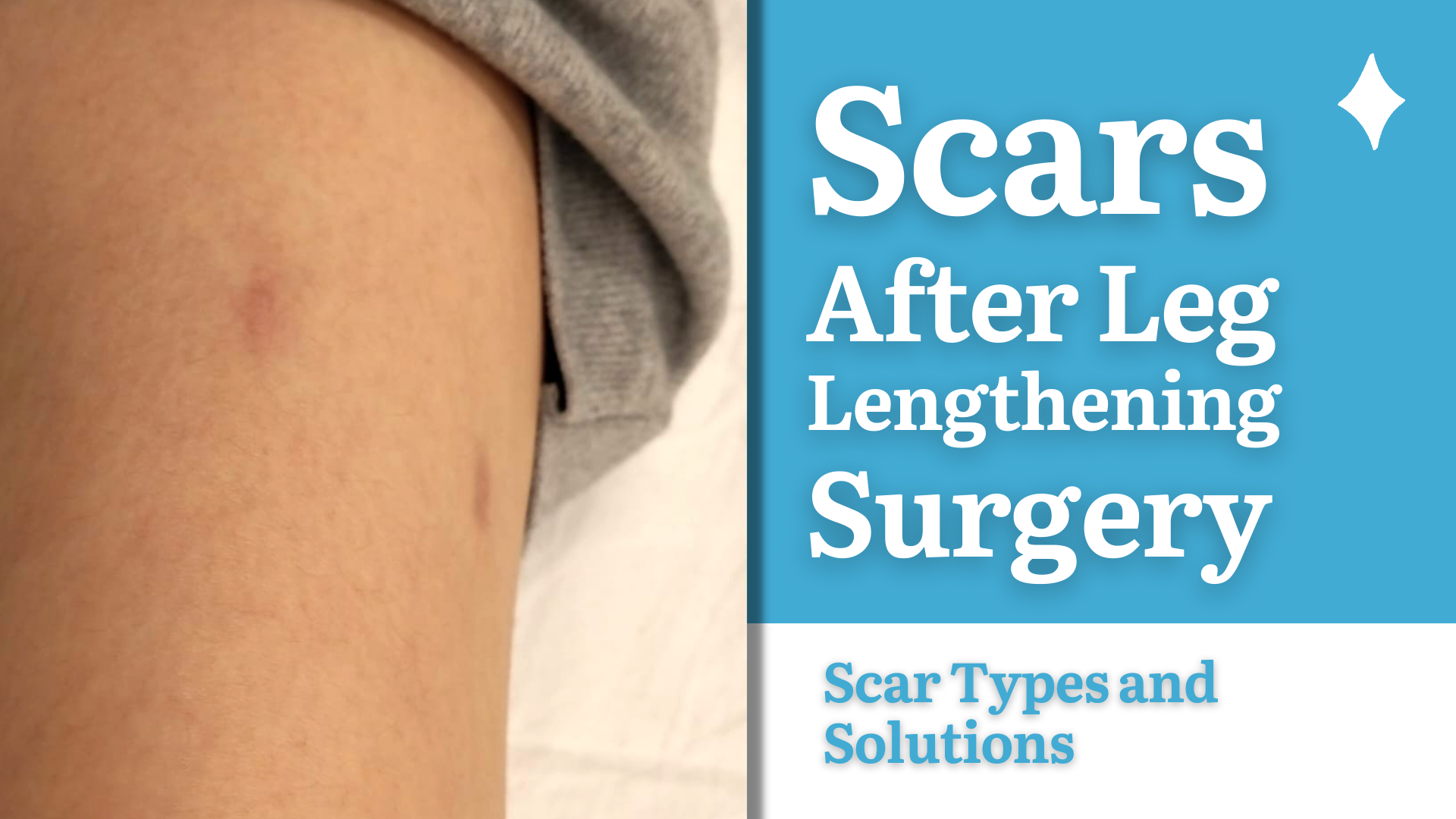
Scar Healing Stages
There are typically three stages for the wound healing process; however, one should remember that wound healing is not linear and wounds can progress both forward and backward through the phases on the road back to health, especially for surgical scar healing.
Stage 1: Inflammatory Phase
As a normal reaction to an injury, inflammation occurs during the Inflammatory Phase, and a clot is formed to halt further bleeding. Blood arteries widen to let vital cells; such as antibodies, white blood cells, growth hormones, enzymes, and nutrients reach the injury site. Redness, heat, pain, and swelling are all symptoms of inflammation, which are caused by these cells.
Stage 2: Proliferation Phase
During the Proliferation Phase, damaged tissue is replaced. A new system of blood vessels is formed to provide the injured tissue with oxygen and nutrients, and the wound closes. Tissue in the early phases of healing is pink or crimson in color, has an irregular texture, and no longer bleeds easily. Infected tissue may seem dark. A new layer of skin cells forms over the wound as the proliferative phase draws to a close.
Stage 3: Maturation Phase
Scars begin to lighten and wounds completely heal during the Maturation Phase. About 21 days after an injury, the "remodeling" process begins and can last for a year or more. However, the healed wound area will always be weaker than the uninjured skin, typically regaining only 80% of the original tensile strength.
Leg Lengthening Surgery Scars Based on the Surgery Methods
External Fixation (Ilizarov and Holyfix)
The two external fixation methods are Ilizarov and Holyfix. Ilizarov is the first limb lengthening surgery method that is created. Both the Ilizarov and the Holyfix methods are outdated and no longer used by our doctor, Assoc. Prof. Dr. Yunus Öç but we still would like to give information about these two methods. The circular external fixator device is used in conjunction with a number of wires and screws placed in the patient's leg as part of the Ilizarov procedure. The external fixator is left in place for a minimum of a year without an intramedullary nail to allow for proper bone consolidation. As a result, the affected leg is likely to develop several surgical scars. Patients who undergo Ilizarov leg lengthening for cosmetic reasons often have many concerns about their appearance after the procedure, in addition to the discomfort, they feel during the lengthening process.
Second, and more significantly, the Holyfix procedure, which is also totally external, creates the most scarring on the leg. The Holyfix technique was created later and is utilized with an external fixator device, but it does not involve connecting the legs with cables. The external fixator is used to keep the legs in place for a year. Compared to the Ilizarov technique, this one is less painful and results in smaller scars, but it still doesn't address the aesthetic issues that arise from the procedure. Instead of the Holyfix and the Ilizarov techniques, we recommend our patients the Precice2, Precice Stryde and the LON (Combined) methods.
Internal Fixation (Precice2 and Precice Stryde)
The entirely internal Precice 2 and Precice Stryde techniques are the most appropriate ones for individuals who seek leg lengthening surgery yet have significant concerns about the scarring. In these techniques, only five little incisions are needed to complete the process. It goes without saying that the skill of the surgeon is the single most important aspect in creating concealable surgical scars.
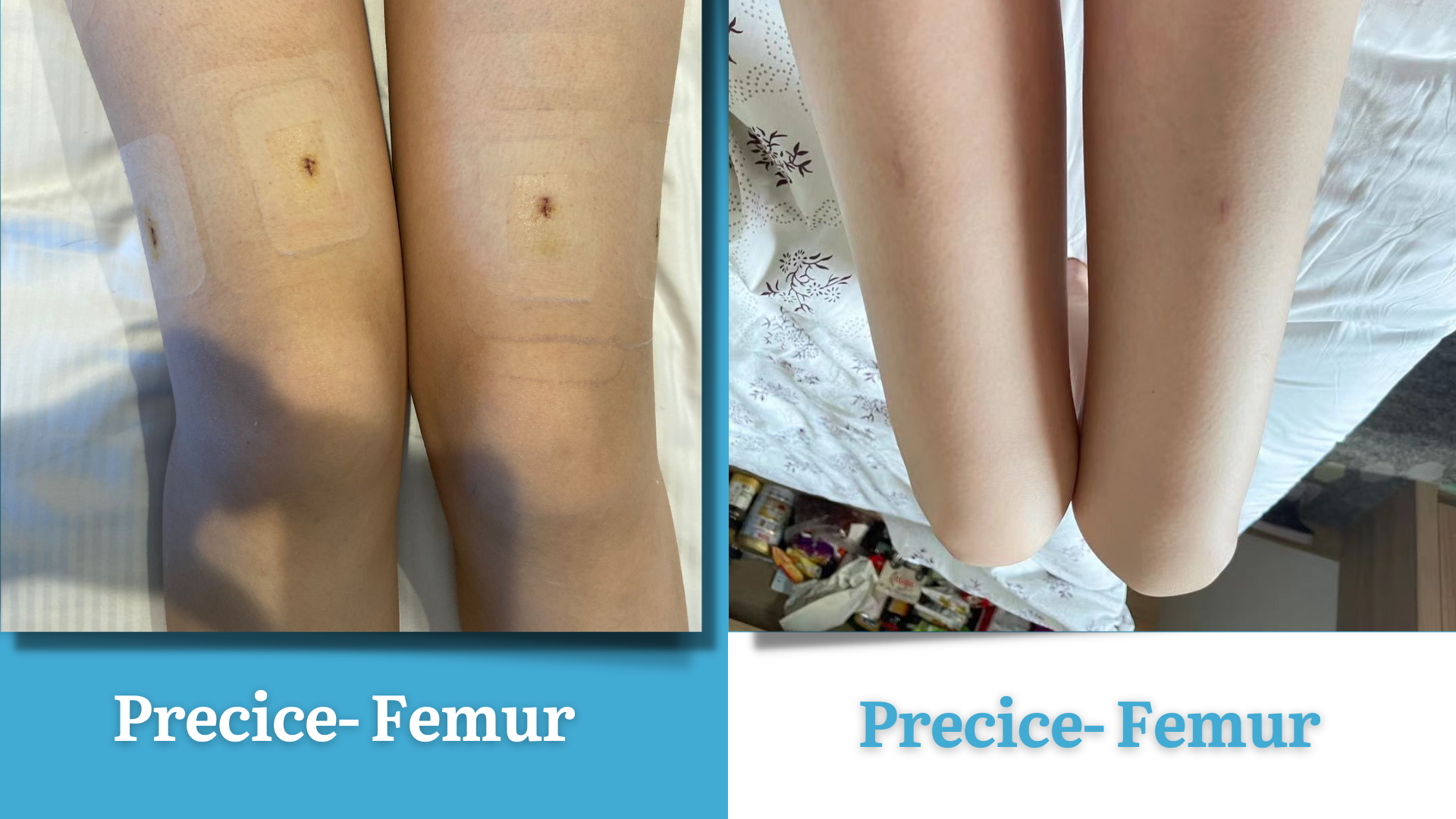
Internal limb lengthening procedures do not involve the use of external fixators. As a result, there is no need to take precautions against contracting an infection.
Similar to other forms of surgery, the Precice 2 and Precice Stryde techniques leave more noticeable scars in the early postoperative period. Within a few months of surgery, these scars will fade significantly. Within a year of surgery, the scars will be nearly undetectable as the skin will have completely renewed itself.
This is the patient’s scars 1 week after the surgery with the Precice2 method:
.webp)
And this is the patient’s scars 2 months after the surgery with the Precice2 method:
.webp)
Internal and External Combined: the LON Method
The LON (Combined) technique is a popular choice since it has a shorter recovery time and less visible scarring than the other external fixation methods (Ilizarov and Holyfix). This is due to the fact that external fixation is necessary for the LON procedure for around three months.
When using this technique, eight surgical scars are left on each leg due to incisions and the external fixator's connection pins. After having the gadget removed surgically, the scars will fade over time.
This is the scars of two different patients from two different recovery periods:
.webp)
The risk of infection and new scar development can be minimized with the LON limb lengthening approach by maintaining clean and regular dressing of the pin sites.
And this is another patient of ours’ scars right after the device removal surgery:
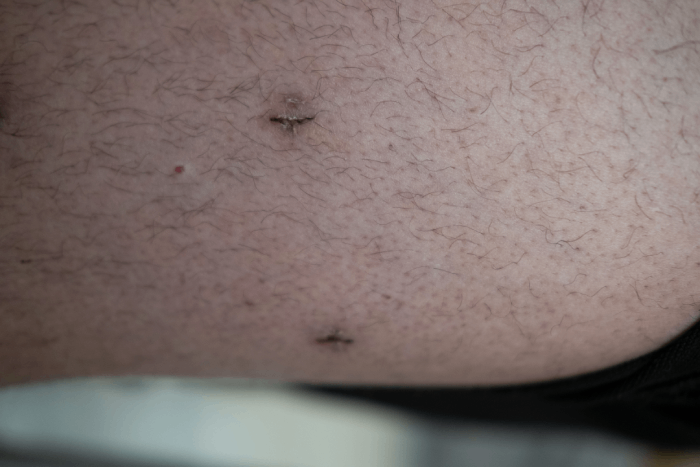
If you would like to see the scarring comparison between the LON(Combined) and the Precice2 methods, you can watch our video below:
How to Treat the Leg Lengthening Surgery Scars?
5 Factors That Affect Scar Healing
As we've seen, the road to recovery after an injury isn't a straight line from A to Z; wounds can make forward and backward progress depending on a number of factors;
Age
The structure and function of the skin are not immune to the ravages of aging. As we get older, we experience a general slowing of all processes, including the stages of wound healing. With age comes a thinning of the skin and a diminished inflammatory response from the body, both of which contribute to a diminished ability to recover from wounds.
Nutrition
A healthy diet is essential for a speedy recovery. If you don't have the building blocks for new cells to replace damaged ones, your wounds won't heal.
Ideal Body Weight
There is an increased risk of infection in wound healing for people who are more than 20% over their optimal body weight.
Skin Hydration
To function properly, the skin needs a constant supply of water. Dry skin (more frequent in the aged population) increases the chance of developing skin lesions, infection, and thickness, all of which slow wound healing. If the skin is too dry, the wound won't heal properly, but if it's too wet, you could have an infection or maceration.
Medication
A person's ability to heal may be slowed by the use of prescription drugs. Nonsteroidal anti-inflammatory medicines, such as aspirin and ibuprofen, are commonly used to treat arthritis, but the American Academy of Orthopaedic Surgeons warns that they may impede the body's natural healing process by reducing the necessary inflammation. Blood coagulation can be disrupted by anticoagulants, and the immune system can be weakened by immunosuppressants, which increases the likelihood of infection.
Although scars won't go away completely, with time and care, most people see a significant reduction in their visibility. The degree to which a scar lightens is highly variable from person to person and from treatment to treatment.
Scarring from the same injury in two distinct but similar areas can look very different, according to studies. This highlights the fact that every scar is different and that it's not always possible to anticipate the sort of scar that will develop in response to a certain incident.
To minimize your height lengthening surgery scars;
- Use Scar Cream
Make sure you get scar cream, usually starting 2 weeks after the surgery.
- Stay out of the sun
Keep your legs out of the sunlight so as to not disrupt the skin's healing process. Sun provides vitamin D which is great for bone healing but you should protect your legs for the scarring healing.
Fractional Laser treatment
Laser treatment is a technique that uses highly concentrated beams of light to heal wounds. A scar will still be visible after undergoing regular laser scar therapy. Instead, they work to conceal or minimize the appearance of a scar. Eventually, these scars might lighten or vanish. When a scar becomes permanent, regular laser treatments can be utilized to remove the outer layer of the injured skin’s surface. They basically smooth the skin to improve tone and look. However, fractional laser treatment is the latest technology that fixes the multiple layers of the skin at once.
Regular Laser Treatment:
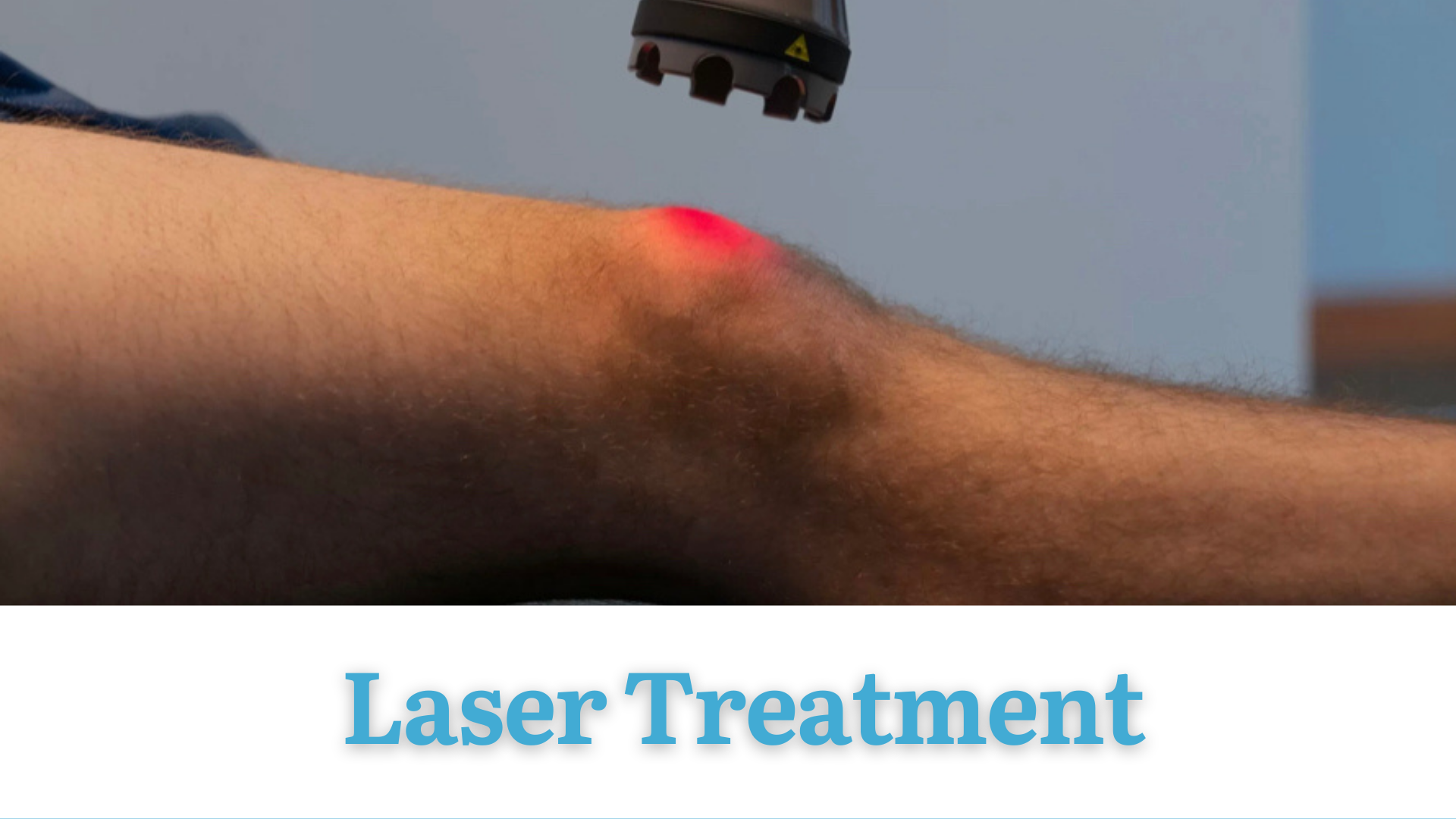
VS
Fractional Laser Treatment:
-2.webp)
Implications and aftercare of scar laser treatment
It could take anything from 3-10 days for your skin to fully recover. Your doctor will provide aftercare instructions shortly after the following therapy. The following are examples of such things:
- It's recommended that you stay out of the sun for four to six weeks after surgery.
- If there is any swelling, use a cold compress or damp washcloth to provide pressure.
- Take non-prescription pain relievers as needed.
- Every day, you must cleanse and moisturize.
As a result, the degree of scarring that may develop after surgery depends greatly on the skill of the surgeon. Revision by a plastic surgeon to remove or lessen the appearance of a scar is an option, but the vast majority of patients do not need this.
If you would like to get more information about the scarring after leg lengthening surgery, please contact our patient consultant.
You will be informed about the lengthening increase, lengthening process, the prices of the surgical methods, the difference of the methods, the risks of the surgery.
Rosaire 2023-06-15 10:52:43
I was wondering how the Fractional Laser Treatment works in practice? Is it painful?
ReplyHeather Byrne 2023-06-15 10:51:52
Does physical therapy has any effect on the scarring? Can it speed up the healing process of the scarring?
ReplyWanna Be Taller - Makbule2023-06-15 11:31
Thank you for your question! Physical therapy plays a crucial role in the overall recovery process during limb lengthening. While it primarily focuses on improving range of motion, strength, and functionality of the limbs, it can indirectly contribute to the healing of scars. Physical therapy techniques, such as massage, mobilization, and stretching, can help improve blood circulation and promote tissue healing. Additionally, targeted exercises and movements prescribed by a qualified physiotherapist can help prevent stiffness and adhesions around the scar tissue, which may enhance the overall healing process. If you have any more questions or require further clarification, please feel free to ask. We're here to assist you! Regards, WBT
Luis Norman 2023-06-15 10:49:35
It's quite a relief to know that the scarring from leg lengthening surgeries can be minimized and even well-hidden.
Reply

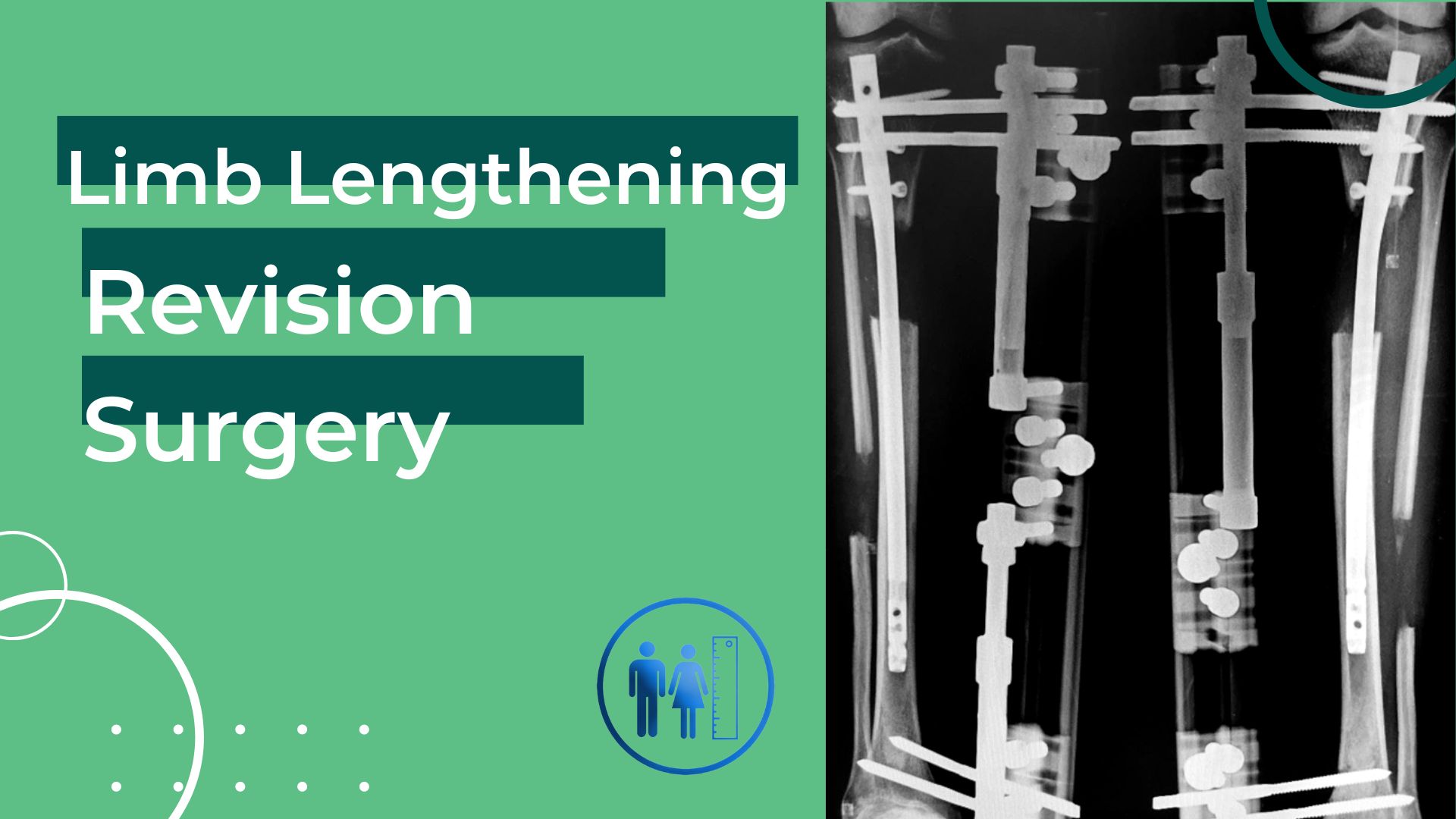
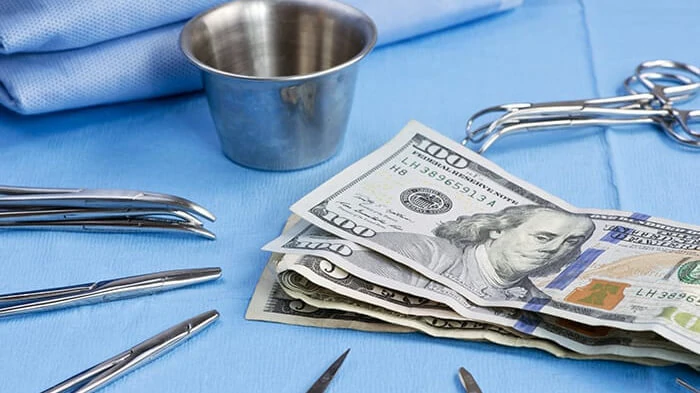

Wanna Be Taller - Makbule2023-06-15 11:29
Fractional Laser Treatment is a procedure used to address various skin concerns such as wrinkles, scars, and uneven pigmentation. During the treatment, a laser device creates tiny, evenly-spaced microthermal zones on the skin, stimulating collagen production and promoting skin rejuvenation. In terms of discomfort, most patients describe the sensation during the treatment as a mild prickling or warming sensation. However, pain tolerance can vary from person to person. To ensure your comfort, a topical anesthetic may be applied before the procedure. It's always best to consult with a qualified dermatologist or medical professional who can assess your specific situation and provide personalized advice. If you have any further questions or would like more information about Fractional Laser Treatment, feel free to ask. We're here to assist you! Reagrds, WBT.